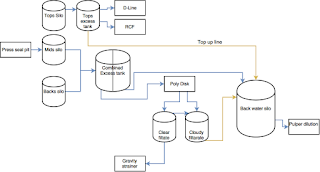Approach flow systems - Basic overview of the Process
Approach flow systems describe the part of the papermaking process between the final stock preparation storage tanks and the headbox of the paper machine.
All paper machines will have an approach flow system, the only difference will be the configuration of that system.
The primary objective of the approach flow system is to prepare the stock for entering the headbox, of the paper machine the tasks are as follows;
- Dilute the stock down to headbox consistency (0.5 - 1.5%)
- Provide protection for the headbox
- Reduce flakes and contaminants from the stock (flakes, dirt, air) entering the Headbox
- Maintain a uniform mixture of pulp within the approach flow
Bellow is a simple diagram depicting the Approach flow leading to a Fourdrinier Machine.
Notice the approach flow of a paper machine can be divided into two areas, Thick stock, and Thin stock system.
Thickstock
Thick stock describes the process where the stock consistency is greater than 1% and Thin stock denotes the process that uses 1% and below. The partition between the two system is the Fan pump where thick stock (3-5%) is diluted to >1%.
The thick stock Process typically starts at the storage chest from the stock preparation plant. depending on the process this pulp can be mixed with other variations of pulp to create more desirable paper properties. One method is to "blend" the fiber streams together using a pipe. the fiber streams all converge on a pipe with a dilution water addition point at one end. this pipe feeds into a blending chest where the pulp is again sufficiently mixed using agitators. in an ideal scenario, the pulp needs to be mixed uni formally to prevent paper properties variations on the machine, for example, Strength, Shade etc.
The thick stock flows into the blend chest via the blending tube with the other fiber streams. Typically this is where machine Broke is added to the primary fiber. The stock then passes through to the machine chest. Here there is a consistency dilution valve that controls the consistency entering the machine chest. The operator typically runs the consistency at around 3-4.5%.
A constant overflow is created in the machine chest to the blend chest, this allows the pulp in the machine chest to be constantly mixed and prevent a "crust" from forming within the tank which can cause flake and lump issues on the machine.
The consistency can be increased when on heavier grades to allow the fan pump speed to slow down. At higher weights, the fan pump can ramp close to its max output flow speed. This speed is controlled by the dry stock control. The theory is that as the consistency increases entering the fan pump less stock is needed to match the desired weight because there is more fiber present in the same volume of water.
The drawback with altering the dry stock control say to 5% at the machine chest is that stock can become flocky entering the headbox and the formation of the sheet can worsen compared with 4.5% consistency. The quality issues are not major but can reduce the quality reading by a few points which can mean a reel failing. By opening the slice the formation can improve on the wire but this leads to its own set of issues on heavier weight grades.
Thin stock System
 |
| Diagram of a Board machine 3 ply thin stock system |
The thin stock system starts at the machine chest. The thick stock from the machine chest flows to the fan inlet of the fan pump (m-70). This is where the thick stock meets the dilution water from the primary silo. The two mix in the fan pump and pump forward to the primary screen. The stock at this moment is about 1% fiber content. The accepted fiber from the primary screen pump forward to the PE (Pulse elimination) tank and then onto the headbox. Rejects from the primary screen go through a 2 stage screen system to remove the final amount of rejects.
Monitoring reject flows helps determine if a blockage has occurred on the screen on the reject pipework. The differential pressure between the inlet of the screen and the outlet should be different but not too high, If the DP is too high it will indicate an issue with the screens.
Air in stock and in the thin stock system can cause forming issues with the paper web once it hits the wire. Uneven fiber speed across the wire, thin patches and holes will form. Air is problematic in stock due to the rapid expansion from leaving the headbox.
Air is removed in a number of ways from the thin stock supply. Each of the pressure screens has an air bleed line from the top center of screen casing. The air is released as it builds up and flows to the open top rejects tank.
De-foamer chemical is added at any point where white water is collected from the wire drainage. drainage from the wire is where the majority of air gets trapped.






